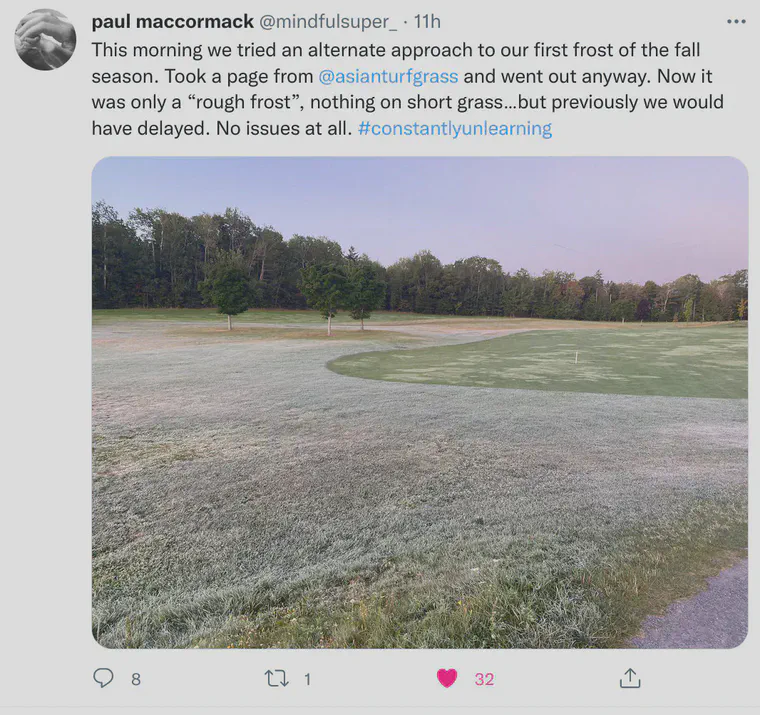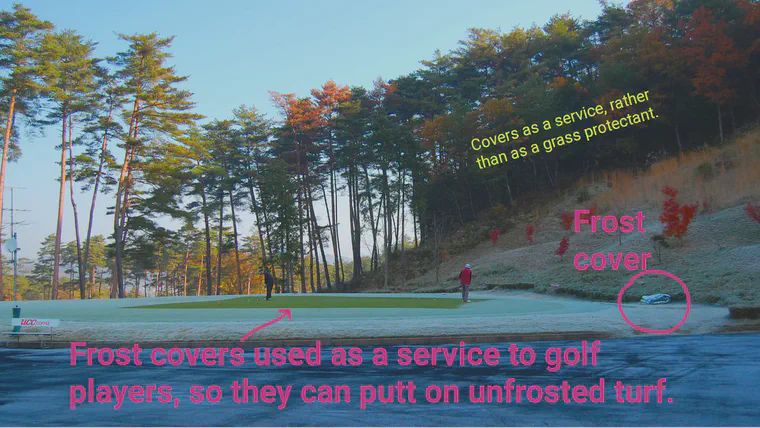An alternative reference for frost delays
Frost delays. As a standard reference, I recommend this one: PACE Turf’s Clubhouse Edition on why frost delays are necessary. That reference explains what can happen and how to remove any risk from frost damage.
If that’s what you want to do, then that’s the only guide you’ll need. But if you want to be adventurous, read on.
Paul MacCormack shared a photo and a note in a tweet, writing:
“This morning we tried an alternate approach to our first frost of the fall season. Took a page from @asianturfgrass and went out anyway.”

I’ve written and talked about frost delays. For a bit of background information on what this “alternate approach” could be, I have linked to some blog posts (which include plenty of photos) and research articles and conversations with experienced greenkeepers about this topic.
An alternative reference for frost delays
When I worked on golf courses in the United States, it was customary to have frost delays. To me that meant no traffic on frosted turf. When I was a golf course superintendent in China, I enforced frost delays. In late summer of 2000, I moved to Japan, and as winter approached, I fully expected that we would have frost delays. I was surprised (and worried) when it was made clear to me that we would not be having delays.
I wrote about that experience in Playing golf in the snow: more greenkeeping adventures from Japan.
In a follow-up post (How to lose 120 million yen with frost delays), I explained how that actually worked, what amount of money was involved in the decision, what the actual damage was, and how the turf looked in the spring.
It turns out, there’s even been research about this. Sure, traffic on frosted and frozen turf doesn’t make it any better. It beats the turf up a bit. But come spring, when the temperatures warm? The trafficked turf is just as good as the untrafficked. Oh, and potassium (K) didn’t help. I wrote about that in Fall potassium and winter traffic on a bentgrass green.

I note that in parts of the world where people are keen to play golf and the courses are operated as a business—places like Japan and Korea—it’s common to make the courses available for play and to make it as convenient for the customers as possible, despite the snow and frost and freezing conditions. I wrote about that, and included even more photos and videos, in Playing golf in ice and snow.
I’ve also talked about frost delays and turf damage in a few recorded conversations. These greenkeepers have some expertise on the topic: one has a PhD in plant biology, another sees thousands of rounds played each winter on frosted turf, and one manages turf just below the Arctic Circle.
- With Dave Kubien in New Zealand
- With Ichizono in Japan
- With Bjarni Hannesson from Iceland
You’ll hear a range of views in those conversations.